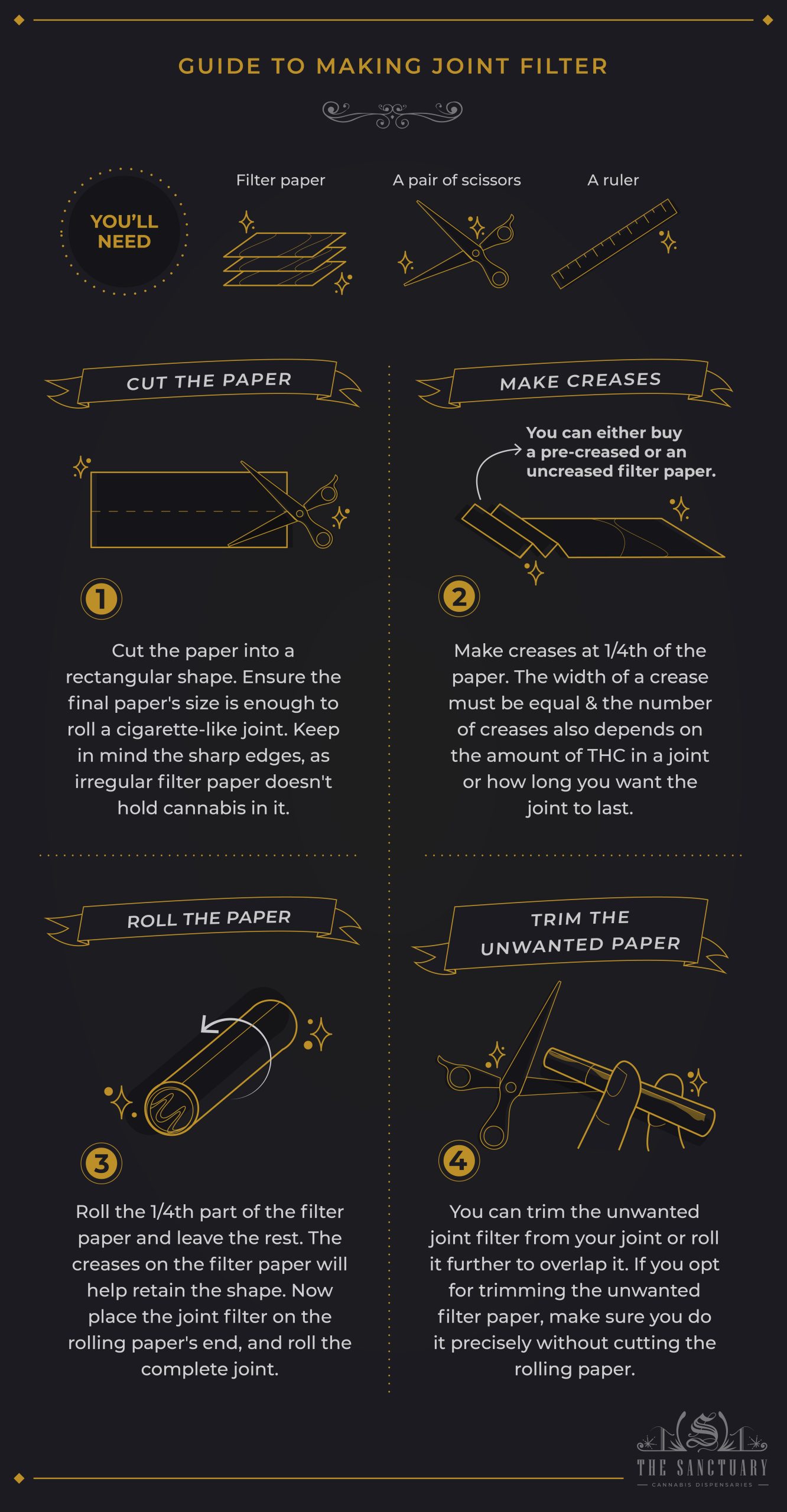Iftikhar Alam
Author
Reviewed by Cannabis Experts
Published on: May 15, 2023 | Updated on: September 11, 2024
Smoking weed becomes much easier when you know how to make a joint filter. Stoners prefer making their own joints rather than buying pre-rolls from dispensaries. However, making DIY joint filters needs skills that you must acquire to fulfill your cannabis cravings.
A joint filter is the easiest way to enjoy every nub of marijuana. Moreover, you don’t have to spend much as every material is affordable and available at local smoke shops. You only have to buy a natural set of joint filter materials and invest 5 – 7 minutes.
So, let’s learn how to make a joint filter.
What is a Joint Filter?
It’s a mouthpiece that filters unwanted cannabis particles from coming into your mouth while smoking weed. Joint filters are important in making a perfect weed joint. They keep the joint intact, ensuring no cannabis roach crumbles while you enjoy it. Furthermore, a joint filter enhances the stability of your joint.
Remember that the cannabis strain you choose for joint sessions also plays an important role. For instance, cannabis having tiny particles after grounding can easily crumble down the joint while smoking weed.
That’s why you must know how to make a joint filter.
Guide to Making Joint Filter

A joint filter maximizes your tripping experience by giving you the most out of weed joints. Here are the five general steps to make a joint filter.
Assemble Materials
You need the following things to make a joint filter:
- Filter paper
- A pair of scissors
- A ruler
You can choose any paper other than filter paper, such as cardboard or any sturdy paper. Ensure the paper you choose for the filter is not made of chemicals because the filter acts as a mouthpiece while smoking weed.
The chemical compounds in the filter paper are harmful to your health because they get included in the inhaling process.
Cut the Paper
Take the filter paper and cut it into a rectangular shape. Ensure the final paper’s size is enough to roll a cigarette-like joint. While cutting the paper, keep in mind the sharp edges, as irregular filter paper doesn’t hold cannabis in it.
Make Creases
After having the rectangular cut filter paper, start making creases at 1/4th of the paper. The width of a crease must be equal to make a perfect joint filter. Besides, you can randomly decide how wide the final joint will be and then make creases accordingly.
The number of creases also depends on your choice, such as the amount of THC in a joint or how long you want the joint to last. For instance, experts recommend making “V” or “M” shaped creases as they are the most common. You can always try new designs while making a joint filter.
Remember that you must first make the crease and then fold the paper. Otherwise, the joint filter will become too tight to contain cannabis.
Pre-Creased Paper
You can either buy a pre-creased or an uncreased filter paper. Both are available at the smoke shop, depending on your preference on which one to buy. Moreover, weed connoisseurs prefer filter paper without creases, allowing them to try different styles while making a joint filter.
On the other hand, a pre-creased filter paper is the preferred option if you are a novice and learning how to make a joint filter.
You will find reusable tips and pre-creased rolling papers from smoke shops. A pack of 50 might cost you around $3, which sometimes comes with a filter and rolling paper. So if you don’t want to practice origami, buying a pack of pre-creased filter paper is a suitable option.
Roll the Paper
After making creases, roll the 1/4th part of the filter paper and leave the rest. You will see the design you made through the hole, probably zig-zag lines. Meanwhile, the creased area will expand if you leave it, which is not a big deal.
The creases on the filter paper will help retain the shape, which will guide you from where you should roll the remaining paper.
Now, place the joint filter on the rolling paper’s end, and roll the complete joint. Both the joint filter and the rolling paper will roll together. Once the rolling is complete, you might be left with an exposed joint filter.
Trim the Unwanted Paper
You can trim the unwanted joint filter from your joint or roll it further to overlap it. That will increase safety while smoking marijuana from the joint.
If you opt for trimming the unwanted filter paper, make sure you do it precisely without cutting the rolling paper. Even the smallest cut in the wrong direction can leak the joint, allowing the cannabis to crumble out.
Once ready with your joint filter, pour some cannabis into the rolling paper and smoke like a pro. Because of filtration, you will notice how better each trip is than the previous one.
Why Should You Use a Joint Filter?
Joint filters enhance the value of your weed-smoking experience. You can enjoy every bit of marijuana after making the perfect joint filter. Moreover, you don’t need to worry about crumbling weed particles or ash from the blunt during your joint sessions.
A joint filter also helps your blunt or joint stay intact in social gatherings. You can also share the joint without worrying about inhaling weed particles. Even if you have a buddy having wet lips, the joint filter will keep the ends open of the joint.
If you are a newbie worried about the joint’s hot embers, the joint filter will protect your fingers and throat. So, it’s a preventive mouthpiece you can easily make at home and avoid tongue burns.
Conclusion
You must know how to make a joint filter at home as it’s a time and money-saving technique. Even if you are new to the cannabis culture, you can buy a pre-creased filter paper and make a joint filter by following the above guide.
So, embrace the art of making joint filters by trying different designs in the creasing phase. You will not have to buy anything after making the perfect joint filter.
The content provided on this blog is for informational purposes only and does not constitute medical, legal, or professional advice. Cannabis use is subject to local laws and regulations, which vary widely by jurisdiction. Always consult with a healthcare professional before starting any new treatment or altering an existing treatment regimen. The authors and publishers of this blog are not responsible for any actions taken based on the information provided herein. Use cannabis responsibly and in accordance with applicable laws. This blog is intended for adults aged 21 and over. The Sanctuary Dispensaries D186, D187.








